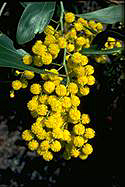

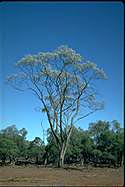



Wattles are members of the genus Acacia and belong to the family Mimosaceae. There are about 750 species of Acacia found throughout Australia. Australia's national floral emblem is Golden Wattle, Acacia pycnantha. Wattle Day is celebrated on 1 September.
Their habitat ranges from coastal to sub-alpine regions and from high rainfall to arid inland areas. Acacias also occur in Africa, South America and throughout other warm areas of the world.
Wattles show a range of foliage and flower types. The true leaves are divided into leaflets (bipinnate), but a large group of wattles develop modified flat leaf-like structures (called phyllodes, - flattened stems) soon after germination.
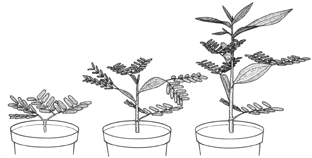

A few species lack true leaves or phyllodes; in these plants modified stems (called cladodes) function as the leaves (Acacia glaucoptera cladodes illustrated).
The foliage colour of wattles ranges from light or dark green to blue or silver-grey.
Flowering times of wattles vary greatly, with the bulk of species flowering in spring and summer. Other species flower during autumn and winter and, with careful selection, it is possible to have flowering wattles in the garden at all times of the year. The flower heads are either spherical (left) or cylindrical (right).
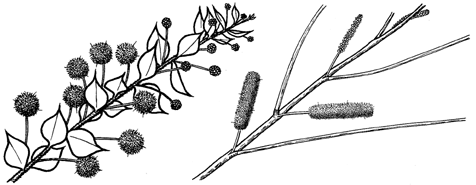
Flower heads vary in colour through cream, pale yellow to gold. One species (Acacia purpureapetala[photo]) has purple flower heads. The flower heads of many species are delicately perfumed.
Wattles make excellent garden plants. They range from prostrate and low-growing species to larger shrubs and shade trees. Most respond to pruning immediately after flowering and, if carried out regularly, pruning can extend the life of the plant.
The main pests are stem borers which can be controlled by probing with flexible
wire or by injecting a few ml of alcohol into the holes. Galls are often more
difficult to control, but removing the effected branches can reduce the problem.
Acacia bug (Eucerocoris tumidiceps) 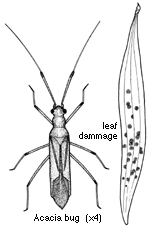 can cause damage to the foliage of wattles with phyllodes and is difficult to
control. Treatment with a systemic insecticide may be required.
can cause damage to the foliage of wattles with phyllodes and is difficult to
control. Treatment with a systemic insecticide may be required.
Wattles are a good source of pollen, some species are popular with bee-keepers. The seeds are also an important source of food for birds. Some wattle seeds also provided a food source for the Aborigines. Mostly they were ground into a flour and cooked like damper.
Propagation from seed is the most common method. Seeds are readily available and can be stored for many years. The very hard seed coat needs to be scarified (worn away) or softened before water can enter and germination can take place. Pouring boiling water over the seeds and leaving them to soak for 24 hours will usually soften them. The infertile seeds will float to the surface and should be discarded. Swollen seeds can be sown, the others can be re-treated.
Many species of Acacia can be grown from cuttings using firm new seasons growth. Cuttings from species with phyllodes are easier to strike than those with bipinnate leaves.
Text derived from the Acacia sections of the 4th edition of Australian Native Plants by John Wrigley and Murray Fagg, published in 1996 by Reed Books Pty Ltd.
The location of these plants in the Australian National Botanic Gardens is based on a new electronic mapping system (MapInfo) currently being assessed.
Only a few sections in the centre of the Gardens have been mapped using this system
and the locations for the species below are based on those sections mapped so far. Where the location in the Gardens is designated as None, it means that the plants are not present in the few sections already mapped - they may exist elswhere in other sections.
| Return to
the Australian National Botanic Gardens Home Page |
Return to
the Acacia - Wattle First Page |